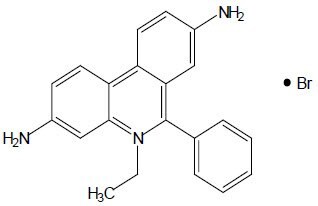Ethidium Bromide
What is ethidium bromide?
Ethidium bromide (EtBr) is a fluorescent dye widely used in molecular biology research. Early usage was as a veterinary trypanocide.14 It is a mutagenic compound that intercalates double-stranded DNA and RNA.1,10 The fluorescence of EtBr increases 21-fold upon binding to double-stranded RNA, 25-fold on binding double-stranded DNA (although histones block binding of EtBr to DNA). Ethidium bromide has been used in multiple fluorimetric assays for nucleic acids.15,16,17 It has been shown to bind to single-stranded DNA (although not as strongly)2 and triple-stranded DNA.18 Because of the binding to DNA, EtBr is a powerful inhibitor of DNA polymerase.4
- Molecular Biology-grade Powder (Product No. E7637) is suitable for use in gel electrophoresis and DNA isolation procedures.
- Aqueous Solution (10 mg/mL) (Product No. E1510) is suitable for use in gel electrophoresis and DNA isolation procedures.
- Molecular Biology-grade Aqueous Solution (500 mg/mL) (Product No. E1385) is suitable for use in gel electrophoresis.
Synonyms: 3,8-Diamino-5-ethyl-6-phenylphenanthridinium bromide; 2,7-Diamino-10-ethyl-9-phenylphenanthridinium bromide; Homidium Bromide; Dromilac; EtBr
Ethidium bromide product details
Appearance: Red to purple powder
Molecular formula: C21H20N3Br
Molecular mass: 394.3
Melting point: 255-266 °C with decomposition1,2
Spectral data:
UV/Vis Absorbance:
Maxima at 210 nm, EmM = 0.20-0.5; 285 nm, EmM = 5.0-10.0; 316 nm, EmM = 50.0; 343 nm, EmM = 40.0 (water)3
Published absorption spectrum (methanol) with λmax at 296 nm and
525 nm1
λmax = 475 nm, EmM = 5.76 (0.66 M glycine buffer)4

Solvent effects on absorbance:
λmax = 480 nm (water); 515 (glycerol); 520 nm (methanol): 520 nm (acetone); 532 nm (ethanol); 535 (DMSO) and 540 nm (pyridine).5 The absorbance maximum relative to water is red-shifted to longer wavelengths upon binding to nucleic acids.6,7
Fluorescence
Excitation/emission wavelengths reported for the EtBr-nucleic acid complex:
Ex at 526 nm, Em at 605 nm (aqueous)8
Ex at 360 nm, Em at 590 nm (in PBS)9
Ex at 525 nm, Em at 600 nm (10 mM TBE, pH 8.0)10
Ex (absorption) at 510 nm, Em at 590 nm.11
Ex (absorption) at 482 nm (blue-green), Em at 616 nm (red-orange).12 The fluorescence yield of EtBr increases as solvent polarity decreases.13
Storage: The solid powder has shown minimal change after two years stored at room temperature, protected from light.
The recommended ultimate disposal method is by incineration as discussed in the SDS.23 Processing solutions through Rohm and Haas Amberlite XAD-16 resin was shown to be effective to the limit of detection, with none of the completely decontaminated solution found to be mutagenic.24,25 We offer XAD-16 as a bulk product, as well as several products that adsorb the dye for easier disposal. See Rezorian A161 cartridges (Product No. 57611 or 57610) and the Extractor™ for EtBr decontamination (Product No. Z361569). A 5 mL Rezorian A161 cartridge can be used to treat more than 16 liters of solution (0.5 mg/liter of EtBr) before dye breakthrough. The luer lock cartridge can be used with 4 mm I.D. tubing, syringes or low-pressure chromatographic systems. The Extractor™ for EtBr decontamination can process up to 10 liters of solution (0.5 mg/liter of EtBr). Other methods of treatment for disposal of aqueous EtBr solutions have been suggested.26,27,28 We have not verified and do not endorse these procedures.
Related Products
Methylene blue (Product No. M4159) was reported as an alternative stain.19 Thiazole orange homodimer (monomer = Product No. 390062) was noted as nonmutagenic, but useful for detecting DNA in agarose gels.20
For use in cell studies, dihydroethidium (Product No. D7008), also known as hydroethidine, is a possible alternative. It is the reduced form of the dye and is converted (dehydrogenated) inside the cell to the ethidium cation, which then intercalates into DNA.21,22
Preparing ethidium bromide
At room temperature, EtBr dissolves in water at 10 mg/mL to give a red solution.2 It should be soluble up to 20 mg/mL in water or up to 2 mg/mL in ethanol.1 It is soluble at 1 part in 750 parts chloroform.3
Stock solutions of EtBr in water or PBS are stable for at least two years at room temperature if protected from light.11
Electrophoresis staining with ethidium bromide
Use in Electrophoresis Staining6
- The dye is usually incorporated into the gel and the electrophoresis buffer at 0.5 mg/mL. Note: Electrophoresis mobility of linear double-stranded DNA is reduced by approximately 15 % in the presence of the dye.
- To stain after gel has been run, immerse gel in electrophoresis buffer or water containing EtBr (0.5 mg/mL) for 30-45 minutes at room temperature.
- Destaining is optional. Detection of small amounts (<10 ng) of DNA is made easier if the background fluorescence caused by unbound EtBr is reduced by soaking the stained gel in water or 1 mM MgSO4 for 20 minutes at room temperature.
References
To continue reading please sign in or create an account.
Don't Have An Account?